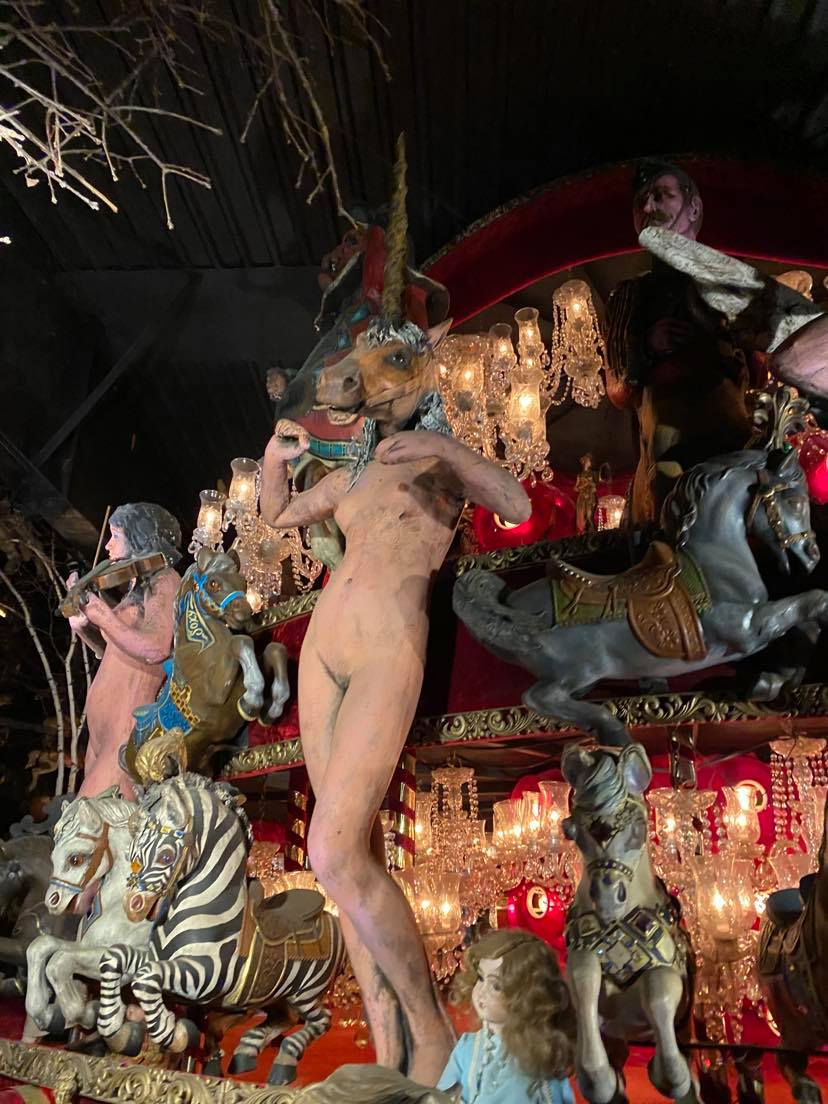- Ben Hellman

- Sep 6, 2021
Updated: Sep 7, 2021

Just before dawn, Rockport, Maine August 26 (photo by author). The Native tribes of New England formed the Wabanaki Confederacy. According to resources from the Abbe Museum of Bar Harbor, ME, the word Wabanaki likely comes from the Passamaquoddy word ckuwaponahkiyik, meaning, “the people of the land of the coming of the light.” Wabanaki territories then are often referred to as the Dawnland in English.
Native New England folk tales have an eerie way of addressing the problems that plague the country today. From the Gluskabe tales we learn that it is wrong to hoard resources, to overhunt or overfish. From the tale of the Corn Mother, we learn that we should sacrifice our needs for the good of the community. From another Gluskabe misadventure, we even get a warning that we shouldn’t mess with the climate because it will destroy the environment. We seem to need these tales now, tales that encourage a different kind of behavior, and with the publication of a new text by partners from academia and the Penobscot community, we have the best curated book of Native New England tales that I have found.
“Still They Remember Me”

“Still They Remember Me,” with a photograph of Penobscot tale-teller Newell Lyon, from University of Massachusetts Press.
“Still They Remember Me” is a collection of tales of the Wabanaki culture hero Gluskabe in a bilingual edition, collected by anthropologist Frank Speck from Penobscot storyteller Newell Lyon in the early years of the 20th Century. The new text was a collaboration between Penobscot language master Carol A. Dana, University of Maine English professor Margo Lukens and University of Southern Maine linguist Conor M. Quinn. It presents thirteen tales of Gluskabe, many of which read to me like the solution to the environmental and economic messes created by a culture that encourages taking and hoarding as much as we can from the planet and not worrying about long term consequences.
The opening tales of Gluskabe’s youth and education present him solving problems in ways that are convenient for him, but bad for everyone else who would follow. The dual-language layout of the text reads almost phrase-by-phrase, allowing the reader to digest Gluskabe’s every thought and action. It is sometimes difficult for him to find game while hunting, so he tricks all of the animals in the world to get into a bag so he can reach in whenever he wants and have one. It is sometimes difficult for his grandmother to catch a fish, so he gathers all of the fish in the world into a small enclosure. The text also gives us the full weight of Gluskabe’s grandmother’s responses to these projects: “My grandchild, you did not do a good thing at all...how will our descendants live in the future since we have as many fish as we want?” And Gluskabe undoes what would be good for him and his grandmother for the good of the people who come after them, a quaint notion. These tales see Gluskabe grow from a young person who is self-centered and self-motivated, into a figure who works to make the world better for his descendants.
Natives, Colonists and the Creation of an American Literature

I will write another piece on some interesting anecdotes from Lisa Brooks’s Our Beloved Kin, a real historian’s history, but it touches on the role Wampanoag people of Massachusetts played in some of the earliest publishing on this continent and features a Greek myth written by a Native scholar filtered through Puritan sensibilities. Brooks is Abenaki and encouraged the writers of “Still They Remember Me” to publish with University of Massachusetts Press. Brooks is also an editor of the series Native Americans of the Northeast, which the volume is a part of.
Another prescient tale I read this summer, a tale referred to in Speck’s Penobscot Man, but not “Still They Remember Me”, is from an historical anecdote in Lisa Brooks’s Our Beloved Kin. Brooks’s text interprets a tale from a land deed signed by a Native female leader in the 1600s who hoped to share the value of sharing with the English colonists who wanted to settle in the lands of her people. Brooks writes that Warrabitta, in a 17th Century agreement with English settlers in Caskoak, Casco Bay on the Maine coast, near Portland, referred to the tale of the Corn Mother, who told the people to break up and plant her body. In the story, her flesh turned to corn and her bone tobacco. The agreement required the English settlers to give a bushel of corn back to the community, an expectation of all Native families to ensure the survival of the community. Warrabitta referred to the Corn Mother to reinforce the value of all goods being shared equally, her attempt, writes Brooks, to integrate the colonists into her society and the economic system that best ensured the survival of her people, to “divide among you the flesh and bone of the first mother...and let all shares be alike.”
I went to a cookout on Labor Day and saw parents encourage their little boy to share a toy helicopter with another. It was an anthropological moment. He had just told the other little boy that he was using it and the other child began to cry. The parents of the boy with the helicopter coached him to try telling the other child that he could have it in five minutes. They wanted him to share, to learn the value of sharing. My parents encouraged me to share and I think most American parents have tried to do the same. This tells me that sharing really is a practice that Americans value, at least in their homes and within their families and circles of friends. It seems incongruent to me that we would teach our children to be kind and welcoming to others with their belongings, but then tolerate our corporations and the wealthiest among us to hoard resources while fellow citizens live in squalor. We could live the way Warrabitta suggested, the way Gluskabe’s grandmother taught him and the way our mothers and fathers and grandparents taught us.
I came upon these texts and tales in an attempt to find the earliest attested Native tales of New England. I read and reviewed three texts by indigenous authors a year ago and was only able to find local Native people to consult with on the tales months after it was published. They warned me that just because a tale was published by indigenous people did not make it necessarily an ancient tale, that folk tales from the Old World may have colonized oral traditions here. The tales from “Still They Remember Me” were taken from the published text and field notes of Frank Speck, who published the tales in 1918 as Penobscot Transformer Tales. Speck also produced the thorough and useful ethnology Penobscot Man, in which he also connects certain tales to tribal names and practices. While the tales themselves have been available and free to read online, “Still They Remember Me” includes updated research on the Penobscot language and is much easier to read than the old Speck pdf. Having read the first five tales to my wife during our trip back from Penobscot Bay, I can report that in the phrase-by-phrase format, the tales sound very much like ones you would read to a very small child, which endeared them more to me than when I first encountered them. My one caveat is that the purpose of teaching the Penobscot language is the controlling factor in the layout of the text and this may not be everyone’s cup of tea. For a language nerd like me, it’s delightful, but I’ve already reformatted this translation of the tales to share with my American literature class. Most of them would navigate between the lines without much trouble, but for kids with reading difficulties or trouble adapting to new visual layouts, what is a hiccup for most people could make the process more difficult than I’d like. Then again, it could be a worthwhile challenge for us, but I’ll take the easier path with new material.
A Bilingual Edition
Screen shots of the actual layout of “Still They Remember Me” as the pages appear in the text, with Penobscot phrases broken into their constituent parts on the left and the English translations on the right. It would be even more interesting to me if Penobscot were related to any of the languages I’ve studied, but it is a fascinating and valuable text nonetheless.
The Penobscot people of Maine belong to a group of tribes referred to as the Wabanaki Confederacy, comprised of the Penobscot, Passamaquoddy, Maliseet, Micmac and Abenaki tribes, which speak distinct, but related languages of the Algonquian language family. Authors Dana, Lukens and Quinn also recently presented a map of traditional Penobscot lands in Maine with Penobscot place names, several of which, in the Penobscot Bay area, refer to a tale of Gluskabe’s moose hunt, a tale told in “Still They Remember Me.” In the story, Gluskabe must put an end to a supernaturally large moose that is terrorizing a village. He chases the moose to Penobscot Bay and leaps across the water, leaving the impression of his snowshoe on a set of rocks in Castine. He kills the moose and part of it can be seen in nearby Cape Roshier, a piece of land referred to as the rump of the moose in Penobscot. Gluskabe throws the moose’s entrails to his dog between two small islands in the bay, an old canoe portage where the rocks are streaked with white, likely the quartzite veins I found at the snowshoe landmark, thought to look like the strings of Gluskabe’s giant snowshoe. I found these locations using the murky details from an old essay by anthropologist Bill Haviland and only discovered the map and “Still They Remember Me” by phoning Castine’s historical society and getting the tip to look for a webinar that had occurred a few months earlier. I have not found copies of the map online.
A Storied Bay

A screenshot of a webinar presenting a map of the landmarks in Penobscot Bay of the place names associated with Gluskabe’s moose hunt from “Still They Remember Me.” The names on this map (labeled in black) are English translations of the Penobscot names. The green text helps relate the locations to the story.
My Wild Moose Chase
A photo-journal of my trek to Dyce Head with my wife and dog to find Gluskabe’s footprint: Dyce Head Lighthouse (now a private residence); Beatrice on the publicly accessible footpath, narrow and very rocky in places; the dauntingly steep set of stairs to the rocks; my foot on Gluskabe’s snowshoe imprint; the quartzite veins that are meant to represent the netting of the snowshoe; Beatrice on the hunt for Gluskabe or perhaps his dog!
A (More) Normal School Year?
I spent my summer studying and trying to learn more about Wabanaki tales and have accumulated more material than makes sense to squeeze in here. I would also like to write about how my high school readers respond to the tales from “Still They Remember Me” and come to a better understanding of a version of the Orpheus myth that a Wampanoag Harvard scholar wrote in 1663. A synergy between work and blog could allow more writing this fall. As a public high school teacher, I was able to maintain a robust blog during the COVID 2019-2020 school year largely because our schedule slowed my district down to about half pace. After my summer off from publishing, I will have to take this school year a step at a time while I see what kind of a pace I am able to research and publish articles. At the moment, I’m still on a journey of discovery with Native New England folklore and expect more pieces on this topic.








































